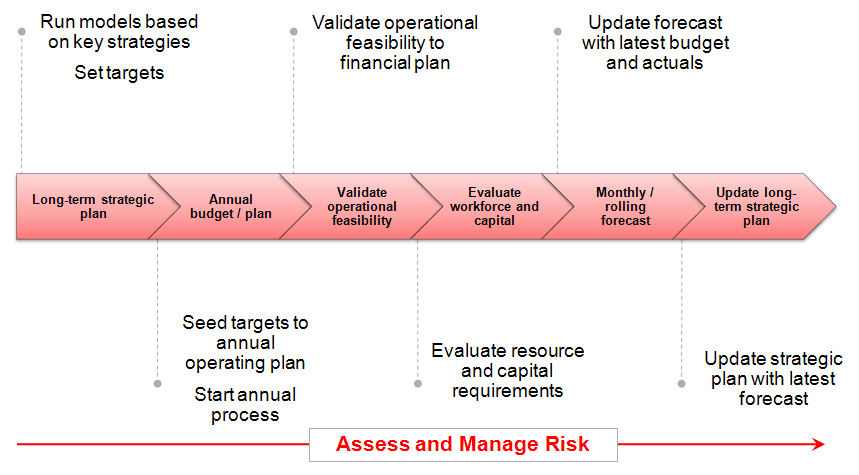When building models we are often confronted with assumptions that evolve over time. In most cases it is important to capture these changes to keep our model relevant. Over the last decade, Business Intelligence solutions have created a culture of self-service IS information. Given this democratization and decentralized access to data has created many opportunities and pitfalls for business analysts and decision-makers. We are going to outline some opportunities and pitfalls relating to shared modeling and a few strategies to get started.
This post presents the opportunities and challenges stemming from moving towards a distributed modeling paradigm in the organization. Also presented is a high-level integrated predictive/collaborative planning process.
When building models we are often confronted with assumptions that evolve over time. In most cases it is important to capture these changes to keep our model relevant. Over the last decade, Business Intelligence solutions have created a culture of self-service IS information. Given this democratization and decentralized access to data has created many opportunities and pitfalls for business analysts and decision-makers. We are going to outline some opportunities and pitfalls relating to shared modeling and a few strategies to get started.
Opportunities for collaborative predictive analytics
- People who are close to the process are making the assumptions
- Group think on estimates
- Decision making flexibility through direct access to data
- Create collaborative decision processes
- Creation of Whitespace projects and opportunities
- 1 version of the truth
Challenges and pitfalls of collaborative modeling with predictive analytics
- Traceability of assumptions: Documentation of who is making in the model’s assumptions and with what data or facts.
- Is the person local – Can we talk to them?
- What methodology was used to derive the assumption
- Where was the data sourced? Is the data source legitimate and recognized in the organization?
- Master Data Management is not in place
- Different business units/geographic regions may have different ways of consolidating data. Forgoing this may result in bad decisions because we are comparing apples to oranges
- Different definitions for similar concepts or queries
- Conflicting Analysis: Two people are tasked with the same analysis but derive vastly different results
- Cost to implement effectively
- Process Redesign
- Training
- Change Management
- Software and infrastructure
Integrating System Data into predictive analytics models built in Excel
 Source: Oracle Corporation, 2010
Source: Oracle Corporation, 2010
One of the most compelling and sexy applications for collaborative modeling is the Planning and Forecasting Process (shown above). You can approach this 2 ways… The first is to go the classical road…
- Build a spreadsheet model with imported tables and pivot tables from the BI and operational systems,
- Run/simulate the model locally the model (Crystal Ball, @risk, ModelRisk, etc.)
- Extract results at a desired risk level i.e. 90%
- Export the risk based single point estimates back to the planning system (to share across org.) using a flat file or CSV.
ModelRisk Professional will enable to do this with much less data manipulation because of its DataObjects features. A data object can be sourced from a worksheet range or an SQL Query. However this will only streamline (though significantly) step one in the classic approach.
Oracle proposes an alternative approach which has several major benefits over the classical approach and 1 drawback. For organizations that work with Oracle EPM’s EssBase (the Crystal Ball EPM Server) and Hyperion Planning, you can build models in Excel where the business logic can be simulated in the back end systems and returned to Excel. The key benefit is that we are getting answers that take into account the organization’s process and logic when producing a Crystal Ball forecast. This also enables the validation of the model/process that is within the planning system. The only drawback is that you need to have EssBase or be willing to implement it.
Source: Oracle Corporation, 2010
Best practices for collaborative modeling success
- BI Applications and/or data integration that can interact and share with modeling tools
- When forecasting, have a coherent and integrated planning process
- Business Rules should be defined on how and where to source data for different types of analysis
- Data sources should be mapped and communicated to the power users
- A review/governance process should be available to support power users to validate / justify their findings & analysis
- Simple rules for managers to validate or invalidate analysis based on the legitimacy of the data sources and methodology within the org.
If you have any questions or would like to share your thoughts, please drop me a line at [email protected].